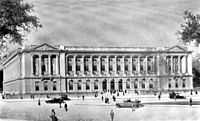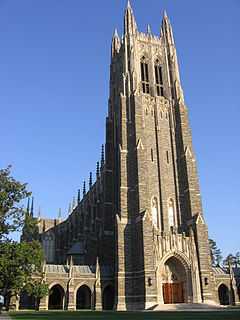Julian Abele
| Julian F. Abele | |
|---|---|
 Julian Abele (photo Duke University Archives) | |
| Born |
Julian Francis Abele[1] April 30, 1881 Philadelphia, Pennsylvania USA |
| Died |
April 23, 1950 (aged 68) Philadelphia, Pennsylvania USA |
| Nationality | USA |
| Alma mater |
Cheyney University (1896) Pennsylvania Museum School of Industrial Art (PMSIA) (1898) University of Pennsylvania, Department of Architecture (B.A., Architecture, 1902)[1] |
| Occupation | architect |
| Notable work |
Duke University Campus Duke University Chapel Cameron Indoor Stadium Allen Administrative Building (completed after his death) |
| Spouse(s) | Marguerite Bulle (m.1925)[1] |
| Children |
Julian Abele, Jr. (architect) Marguerite Marie Abele Nadia Boulanger Abele[1][2] |
| Parent(s) |
Charles Abele Mary Adelaide Jones Abele[1] |
| Relatives |
Absalom Jones (Episcopalian minister) Julian Abele Cook Jr. (judge)[3] Julian Abele Cook (architect)[3][2] |
Julian Francis Abele (April 30, 1881 – April 23, 1950) was a prominent African-American architect, and chief designer in the offices of Horace Trumbauer. He was the primary designer of the west campus of Duke University (1924–54).[4] He contributed to the design of more than 400 buildings, including the Widener Memorial Library at Harvard University (1912–15), the Central Branch of the Free Library of Philadelphia (1918–27), and the Philadelphia Museum of Art (1914–28). Abele's contributions to the Trumbauer firm were great, but the only building for which he claimed authorship during Trumbauer's lifetime was the Duke University Chapel.
Background
Julian Abele was born in Philadelphia into a prominent family. His maternal grandfather was Robert Jones, who in the late eighteenth century founded the city's Lombard Street Central Presbyterian Church. He was also related to Absalom Jones, who established the African Episcopal Church of St. Thomas in 1794, the first black church in Philadelphia. A cousin, Julian Abele Cook, also practiced architecture and went on to design Howard University, and Abele's son, Julian Francis Abele, Jr. was an architectural engineer.
His temperament and his life defy easy characterization. He was a dedicated francophile, and his wife was French. A devotee of the Philadelphia Orchestra as well as of the University of Pennsylvania football team, he was reserved and always immaculately dressed. One friend noted that even on vacations at the beach he always wore his suit to the boardwalk.
Abele worked in many media: watercolor, lithography, etching, pencil; in wood, iron, gold and silver. He designed and constructed all his own furniture, even doing the petit-point himself. While he knew many historic styles, he seemed to love Louis XIV French most of all.
Education

Abele attended the Quaker-run Institute for Colored Youth,[5] which later became Cheyney University, where he excelled in mathematics,[6] and was chosen to deliver the commencement address. In 1898, he completed a two-year architectural drawing course at the Pennsylvania Museum School of Industrial Art (PMSIA), where he was nicknamed "Willing and Able." He won a number of awards and, during his senior year, headed the school's Architectural Society.
Abele was the first black student to enroll in the Department of Architecture at the University of Pennsylvania, and became the department's first black graduate in 1902.[6] This achievement was all the more noteworthy for the restrictions black students faced at the university, including not being able to live on campus or dine at the school's cafeteria. On projects assigned to pairs of students, he partnered with Louis Magaziner, the only Jewish student in the department, who also faced discrimination.[7] This was the basis for a lifelong friendship between the two.
During the next few years, he attend classes at the Pennsylvania Academy of the Fine Arts, and worked part-time for a local architect. Under the financial sponsorship of Philadelphia architect Horace Trumbauer, he traveled through France and Italy, an experience that was to influence his design work throughout his life.
École des Beaux-Arts
Abele's descendants contend that he studied at the École des Beaux-Arts in Paris during his stay in Europe.[8] But Sandra L. Tatman, co-author of The Biographical Dictionary of Philadelphia Architects, 1700-1930, states that there is no record of his having been enrolled in the 3-year certificate program at the École.[9] She allows that he may have been permitted to informally sit in on the atelier. She also notes that Abele listed travel to France, Italy, England, Germany, Switzerland, and Spain on his membership application for the American Institute of Architects, but not study at the École des Beaux-Arts.
The fact is difficult to prove or disprove as there was a fire at the École which destroyed many early records. Abele's grandson contends that he was caring for a sick relative shortly after graduation from the University of Pennsylvania.[10] However there are original drawings housed at the Athenaeum in Philadelphia from his European tour, and a sketch gothic house in Tours, France, dated 1915 was published in the AIA/T-Square Yearbook in 1915.
Career
In 1906, Abele joined the Trumbauer firm as assistant to chief designer Frank Seeburger. When Seeburger left the firm in 1909, Abele advanced to chief designer. Abele's stature within the firm was no secret; he was the second-highest paid employee.
Following Trumbauer's death in 1938, the firm continued until 1950 under the name "Office of Horace Trumbauer," co-headed by Abele and William O. Frank. Commissions were hard to come by during The Depression and World War II, but the firm completed Cameron Indoor Stadium (1940) at Duke University, and later made additions to Duke's Library (1948), and designed Duke's Allen Administrative Building (1954).
When Abele joined the American Institute of Architecture in 1942, the Philadelphia Museum of Art's director, Fiske Kimball, called him "one of the most sensitive designers in America". Art historian David B. Brownlee studied the 12-year effort to design and build the Philadelphia Museum of Art. He credits Trumbauer architect Howell Lewis Shay with the building's plan and massing, but notes that the final perspective drawings are in Abele's distinctive hand.[11]
Despite being the primary designer of Duke University, Abele was refused accommodations at a Durham hotel during a visit to campus.[7] Additionally, it was not until 1988 that a portrait of him was displayed at the University.
Family
In 1925, at age 44, he married Marguerite Bulle, a French pianist twenty years his junior. They had three children: Julian Abele, Jr., Marguerite Marie Abele (died young), and Nadia Boulanger Abele. His wife left him in 1936, married a musician named Jozep Kowalewski, and had three additional children. Because Abele and his wife never divorced, the Kowalewski children shared in his estate.[2]
He died from a heart attack in 1950, in Philadelphia.[12]
Legacy
- The Allen Administrative Building at Duke University, which he designed, was completed after his death.
- In 1989 the university finally allowed a portrait of Abele on campus, which he was the primary designer of to 1950. It was the first portrait of an African-American displayed to ever be on the campus.[12]
- On August 17, 2012, construction began on Julian Abele Park, at 22nd & Carpenter Streets in Philadelphia.[13][14]
Gallery
-

Gothic House, Tours, France (1915) sketch by Abele.
-

Duke University Chapel, Durham, NC (1932).
-

Cameron Indoor Stadium, Duke University, Durham, NC (1940).
-

Allen Administrative Building, Duke University, Durham, NC (1954).
-

Krzyzewskiville Lawn at Cameron Indoor Stadium, Durham, NC. (2010)
See also
References
- Tifft, Susan E., "Out of the Shadows: After decades of obscurity, African-American architect Julian Abele is finally getting recognition for his contributions to some of 20th-century America's most prestigious buildings", Smithsonian magazine, February 2005
- ↑ 1.0 1.1 1.2 1.3 1.4 "PENN BIOGRAPHIES: Julian Francis Abele (1881-1950)", University of Pennsylvania Archives
- ↑ 2.0 2.1 2.2 Cf. Tifft 2005
- ↑ 3.0 3.1 Wilson, Dreck Spurlock, African-American Architects: A Biographical Dictionary, 1865-1945, Taylor & Francis, Dec 12, 2003. Cf. p.144 Biographical entry for Julian Abele Cook (1904-1986), an architect. Judge Julian Abele Cook, Jr. is the son of Julian Abele Cook, the son of Julian Abele's sister Elizabeth Rebecca Abele Cook.
- ↑ "Julian Abele, Architect". Library.duke.edu. 2010-05-26. Retrieved 2012-01-05.
- ↑ "75th Anniversary - Julian Abele". Libwww.freelibrary.org. Retrieved 2012-01-05.
- ↑ 6.0 6.1 Webster, Josephine Faulkner. "Julian Francis Abele (1881-1950)." In Wilson, Dreck Spurlock (Ed.) (2004). African-American Architects: A Biographical Dictionary, 1865-1945, pp. 1-3. Taylor & Francis.
- ↑ 7.0 7.1 Henry Magaziner, son of Abele's U. of P. classmate and friend Louis Magaziner, in a 1989 interview. Quoted in Susan E. Tifft, "Out of the Shadows," Smithsonian Magazine, February 2005.
- ↑ "75th Anniversary - Julian Abele". Libwww.freelibrary.org. Retrieved 2013-07-04.
- ↑ Biography: Abele, Julian Francis (1881 - 1950), from Philadelphia Architects and Buildings.
- ↑ Personal interview with Julian Abele's grandson, Julian, in 1988.
- ↑ David B. Brownlee, Making a Modern Classic: The Architecture of the Philadelphia Museum of Art (Philadelphia Museum of Art, 1997), pp. 60–61, 72–73.
- ↑ 12.0 12.1 William E. King (2009). "North Carolina Architects & Builders: Abele, Julian Francis (1881-1950)". North Carolina State University Libraries.
- ↑ Friends of Julian Abele Park Website
- ↑ "Julian Abele Park Ribbon Cutting", March 24th, 2009
External links
| Wikimedia Commons has media related to Julian Abele. |
- Abele, Julian (1881 - 1950) — "Philadelphia Architects and Buildings" biography.
- Julian Abele: Hidden in the Shadows — Duke University Historical Note, University Archives.
- Julian Abele — at the Pennsylvania Museum School of Industrial Art.
- The Winterthur Library — Overview of an archival collection featuring Julian Abele.
|